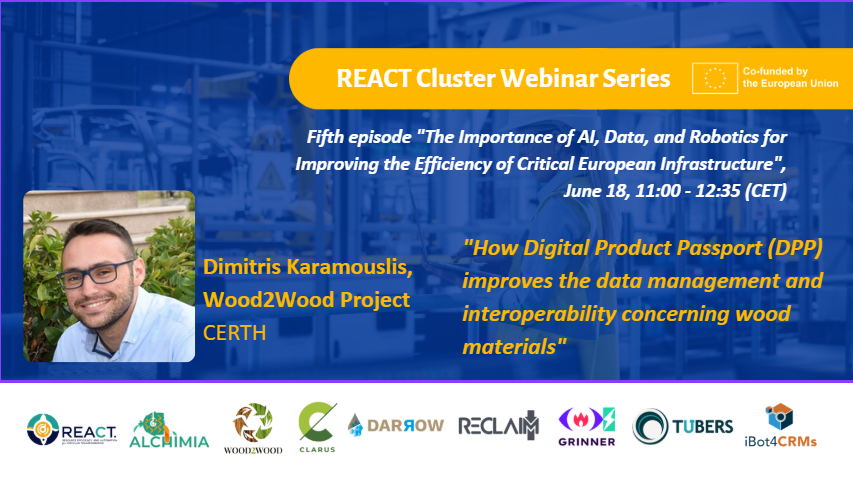
On June 18, Wood2Wood project had the privilege of presenting on the importance of Digital Product Passport (DPP) in improving circular flow of materials, especially wood materials. The presentation was part of the REACT Cluster webinar series on the “Importance of AI, Data and Robotics for Improving the Efficiency of Critical European Infrastructure” organised by EU-funded Tubers Project.
The REACT Cluster stands for “Resource Efficiency and Automation for Circular Transformation”, and consists of eight Horizon Europe projects including ALCHIMIA Project, CLARUS Project, DARROW Project, RECLAIM Project, GRINNER Project, iBot4CRMs project, Tubers Project and Wood2Wood Project. In the webinar series spanning April to June, all the eight European Union-funded projects teamed up as a European cluster to demonstrate how AI-driven innovations can enhance sustainability, reduce waste and drive strategic autonomy in European industrial sectors.
In the final episode of the webinar series, Dimitrios Karamouslis from Centre for Research & Technology Hellas (CERTH) represented the Wood2Wood project and spoke on the contribution of Digital Product Passport’s (DPP) towards improving Data Management and interoperability in wood materials.
In his presentation, among other DPP features, he spoke on:
➡️ Compliance-Ready architecture that supports future European Digital Product Passport (DPP) regulations, ensuring scalability.
➡️How DPP will facilitate collaboration by aligning diverse actors in the construction, health, and chemical sectors through a shared digital language.
And how will the DPP application bring data to life?
🗣️ Dmitrios Karamouslis said: “The DPP page showcases all wood types on the platform. Currently, 9 material types have been identified in the W2W project for enhanced material tracking. Authorised users can, of course, take this further by adding new products to databases, using the Create New Graph Button. This feature helps the team to add more to the DPP by keeping the project’s data up to date and complete.”
This presentation is especially relevant for stakeholders in the Construction and Demolition (C&D), and Furniture sectors who want to adopt DPPs to improve circular flows of materials.
